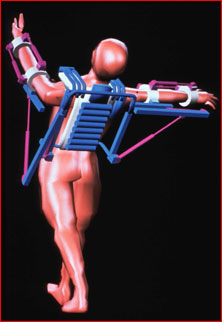relevant works
(1)
Paul Pfeiffer
“Four Horsemen of the Apocalypse,” “The Long Count (Rumble in the Jungle),” “John 3:16,” etc.
(2001 – ongoing)

“There’s definitely a thrill. There are certain images…scenes that I feel captured by. There’s something special about the spectacle of seeing a human being at the center of the gaze of thousands of people. To me, it’s thrilling and also terrifying. There’s something very compelling about it to me. I feel empathy for the players on the court, and admiration when somebody’s able to shoot a three-point shot amidst all the hoopla.”
“In the video ‘John 3:16’…a reference to a passage so often quoted that its sort of the Biblical code for the New Testament that gives you the formula for salvation and eternal life. There’s an interesting kind of resonance that I see between this idea of a formula for salvation and eternal life and the promise of digital media that never break down and literally can live forever…that can always be copied endlessly. In a way, the medium itself represents a kind of promise that almost has spiritual overtones.”

“What I’m really interested in is where the medium fails, so that what you are seeing is the point at which the erasure can’t happen seamlessly. If the editing was done perfectly, then you wouldn’t see where the figure was at all, but in ‘The Long Count’ triptych you always do. There’s always this trace of where the figure was, and in a way you’re seeing the failure of my hand and the failure of the medium, and that’s kind of the ghost that’s left. And it’s that point of failure that I’m really interested in.”
– Paul Pfeiffer
“a 37-minute piece involving seven live performers in an installation that includes video. The action centers on the transcontinental production of “chakra juice,” a magic elixir, one assumes, distilled from human sweat. It comes in the seven colors ascribed in Indian medicine to the body’s seven force centers, located at intervals from the bottom of the spine to the crown of the head. Performed continuously in a 37-minute cycle Wednesday through Saturday from 2 through 8 p.m., “Seven” combines the artists’ interests to entertaining, if not completely seamless effect.
At one end of the assembly line is a New York-based laboratory (the gallery) where sweat is harvested after some typically Rottenbergian exertions by several performers, and reserved in vessels made of a special clay; the clay arrives from the African savannah through the kind of pneumatic tubes once common to department stores. The African side of the operation, conducted by the residents of a tiny, isolated village, appears on television monitors.
With colored lights flashing, things zipping back and forth across the Atlantic, and liquids and solids changing state and hue — all under the watchful eye of a lab technician who conducts herself with the aplomb of a skilled illusionist — there is quite a bit of firsthand action to follow, most of it in line with Ms. Rottenberg’s aesthetic. But gradually the on-screen drama takes over; the savannah is not only mesmerizingly beautiful, it is also the juice’s destination. The closing scene, a kind of performance within the performance, seems to be mostly Mr. Kessler’s. It is unexpectedly dazzling, as, in a different way, is the realization that all this human effort we’ve just witnessed is for nature’s benefit.”
– Roberta Smith, NYtimes
(3)
Mika Rottenberg
“Tropical Breeze,” “Mary’s Cherries,” “Squeeze,” “Dough,” etc…
(apologies for this video, you don’t need to see her apartment, but it does show a good sampling / smattering of her work, which is hard to find in high quality online…)
also:
www.nytimes.com/2010/11/26/arts/design/26galleries-MIKAROTTENBE_RVW.html
www.nicoleklagsbrun.com/rottenberg_home.html
(4)
Jeremy Hutchison
“Err” (2011)

“Emails were sent to factories all over the world. These requested that one of the production line workers produce an incorrect version of the product they make every day. 17 dysfunctional objects are shown alongside reams of confused correspondence, FedEx receipts, customs certificates and cardboard packaging.” – JH
we-make-money-not-art.com/archives/2011/11/err-a-conversation-with-jeremy.php#.URxhOlp_Uts
jeremyhutchison.com/work/project2.html
(5)
Harun Farocki
“Deep Play” (2008)

“Deep Play is a multi-channel video installation in which Farocki simultaneously projects full-length broadcasts of the 2006 FIFA World Cup final from 12 different vantage points. These include the official live TV broadcast, the artist’s own recording of the event, stadium surveillance, real-time action charts of player and coach statistics, 3D animation recreations, among others. It’s an all-encompassing and visually exhausting work – just imagine dissecting Zidane’s head-butt from 12 different angles. It’s pretty overwhelming.
And “overwhelming” is precisely what Farocki is exploring. Deep Play is a meticulous examination of a single event, a massive cultural spectacle watched by over 1.5 billion people across the globe. While rich in specificity, it’s impossible for the viewer to focus on any one thing at a time. Farocki doesn’t give his viewers a break. We are bombarded with data – facts, viewpoints, images – and even though it’s all extremely controlled and organized, we lack time and space to process everything for ourselves. Consequently, in spite of the overabundance of visual information, we are not seeing more or better. We are entranced – constantly distracted, not concentrated.
Deep Play, then, ends up being about much more than a football match. It references key concerns in Farocki’s oeuvre: the dynamics and politics of image production, mass circulation, and perhaps most importantly, the effects those have on individual and collective reception. Farocki demonstrates that how we perceive and witness images – our own subjectivity – is just as important, if not more, than the image itself.” – Artlog






